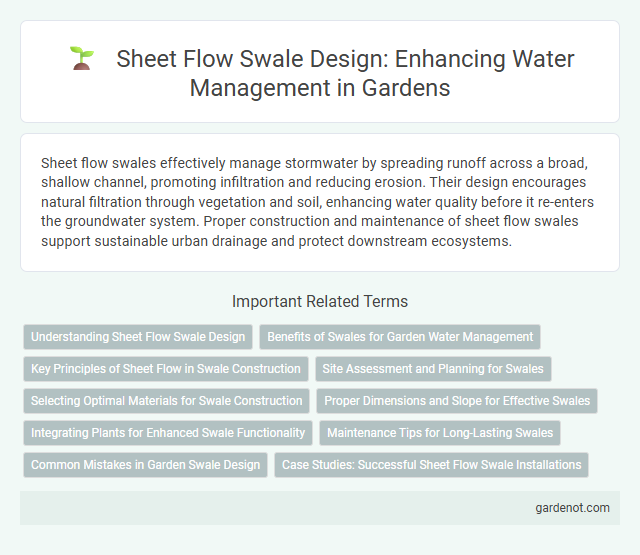Sheet flow swales effectively manage stormwater by spreading runoff across a broad, shallow channel, promoting infiltration and reducing erosion. Their design encourages natural filtration through vegetation and soil, enhancing water quality before it re-enters the groundwater system. Proper construction and maintenance of sheet flow swales support sustainable urban drainage and protect downstream ecosystems.
Understanding Sheet Flow Swale Design
Sheet flow swale design effectively manages stormwater by promoting uniform overland flow across a gentle slope, minimizing erosion and maximizing infiltration. Key aspects include calculating appropriate swale length and cross-sectional area to accommodate peak runoff rates, ensuring a stable bottom slope, and incorporating vegetation for flow resistance and sediment control. Proper design enhances water quality by facilitating pollutant removal and reducing downstream flood risks in urban and agricultural settings.
Benefits of Swales for Garden Water Management
Sheet flow swales enhance garden water management by efficiently capturing and directing runoff, minimizing soil erosion, and promoting groundwater recharge. These shallow, vegetated channels slow water movement, allowing for better infiltration and nutrient absorption, which supports healthier plant growth. Incorporating sheet flow swales in garden landscapes reduces the need for irrigation and helps maintain sustainable water cycles.
Key Principles of Sheet Flow in Swale Construction
Sheet flow in swale construction involves the uniform movement of stormwater over a broad surface to facilitate infiltration and reduce runoff velocity. Key principles include ensuring a gentle slope of less than 5% to maintain laminar flow, designing wide and shallow swales to maximize contact with vegetation and soil, and using appropriate vegetation to promote sediment deposition and increase water absorption. Properly implemented sheet flow enhances groundwater recharge, prevents soil erosion, and improves overall water quality within the swale system.
Site Assessment and Planning for Swales
Site assessment for sheet flow swales involves analyzing topography, soil infiltration rates, and existing drainage patterns to ensure effective water capture and filtration. Planning requires designing swale dimensions and slopes to manage sheet flow volume while promoting groundwater recharge and preventing erosion. Proper site evaluation enhances swale functionality in stormwater management and landscape sustainability.
Selecting Optimal Materials for Swale Construction
Selecting optimal materials for sheet flow swale construction involves prioritizing permeable soils like sandy loam or gravel to enhance infiltration and reduce runoff. Incorporating native vegetation with deep root systems stabilizes swale banks and improves water absorption. Using geotextiles beneath the soil layer can prevent erosion while maintaining efficient water flow through the swale system.
Proper Dimensions and Slope for Effective Swales
Sheet flow swales require proper dimensions and slope to effectively manage stormwater runoff and promote infiltration. A typical swale should have a gentle slope between 1% and 5% to prevent erosion while facilitating water movement and infiltration. Dimensions vary based on drainage area, with common widths ranging from 4 to 10 feet and depths from 6 to 18 inches to ensure adequate capacity and vegetation growth.
Integrating Plants for Enhanced Swale Functionality
Sheet flow swales leverage dense vegetation to slow runoff, increase infiltration, and filter pollutants effectively. Integrating native plants with deep root systems enhances soil stability and promotes groundwater recharge by maximizing water retention. Strategically selected species improve nutrient uptake, reduce erosion, and support overall swale functionality for sustainable stormwater management.
Maintenance Tips for Long-Lasting Swales
Regular inspection and removal of debris, sediment, and vegetation overgrowth in sheet flow swales prevent clogging and maintain optimal water infiltration. Periodic regrading ensures proper flow distribution and avoids erosion or ponding issues. Implementing native, deep-rooted vegetation stabilizes soil and enhances pollutant filtration for sustainable swale performance.
Common Mistakes in Garden Swale Design
Common mistakes in garden swale design include improper grading that prevents sheet flow from dispersing evenly, leading to water pooling and erosion. Insufficient soil permeability and lack of vegetation cover reduce infiltration efficiency, causing runoff issues. Failure to account for the swale's placement relative to existing landscape contours results in ineffective water management and potential flooding.
Case Studies: Successful Sheet Flow Swale Installations
Sheet flow swale installations have demonstrated effective stormwater management in urban and agricultural settings, significantly reducing surface runoff and soil erosion. Case studies from the Chesapeake Bay watershed revealed that well-designed sheet flow swales improved water infiltration by up to 40%, enhancing groundwater recharge. In California, swales integrated with native vegetation showed a 30% increase in pollutant removal from surface water compared to conventional drainage systems.
Sheet flow swale Infographic

 gardenot.com
gardenot.com